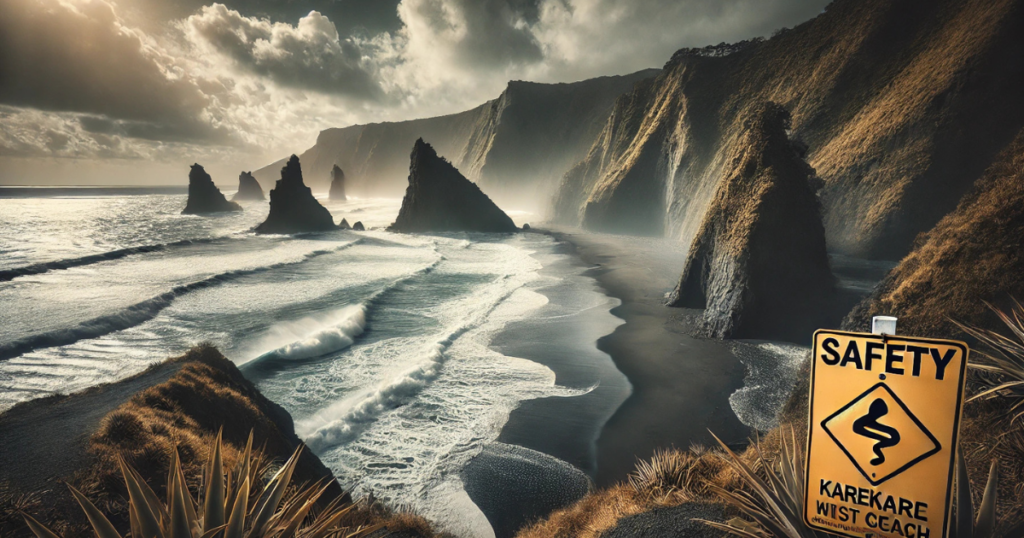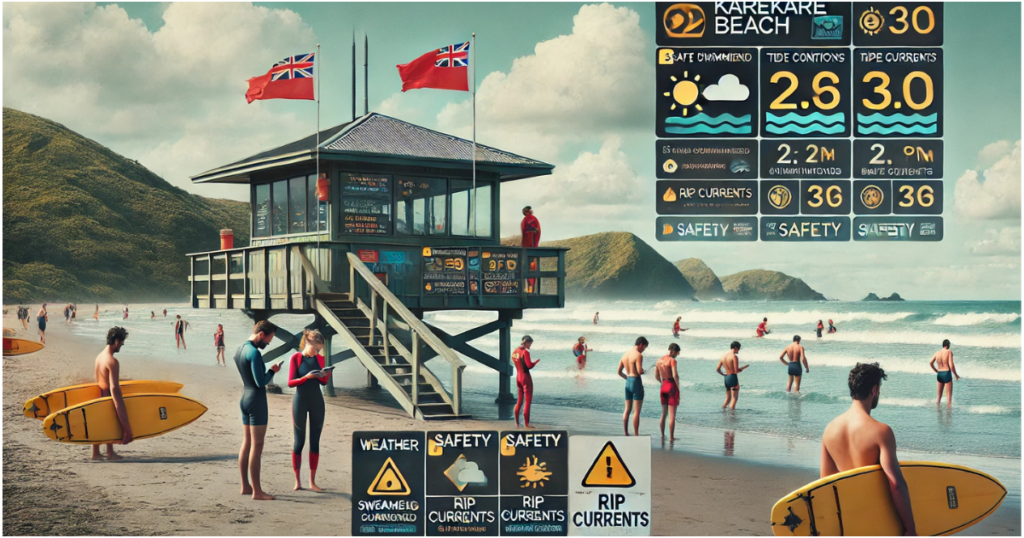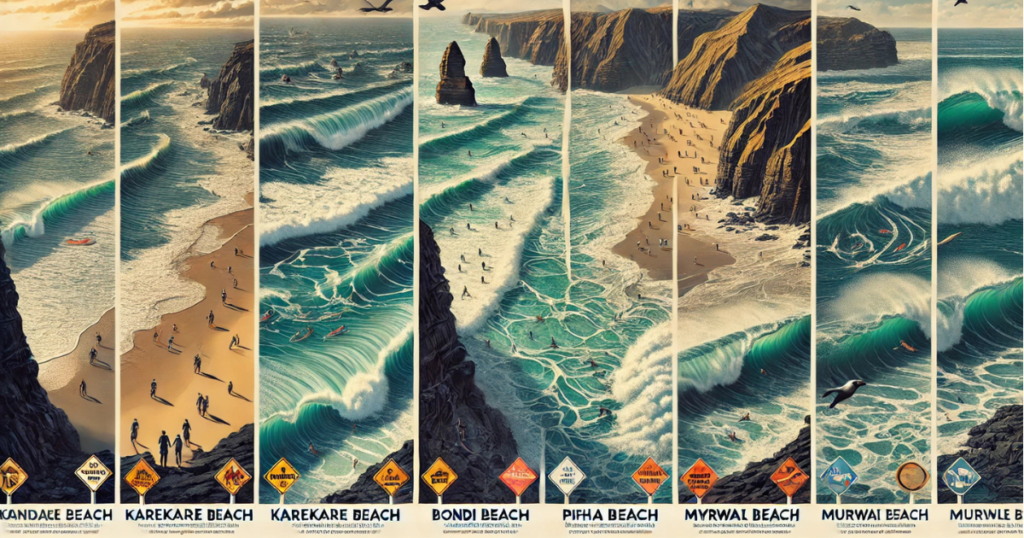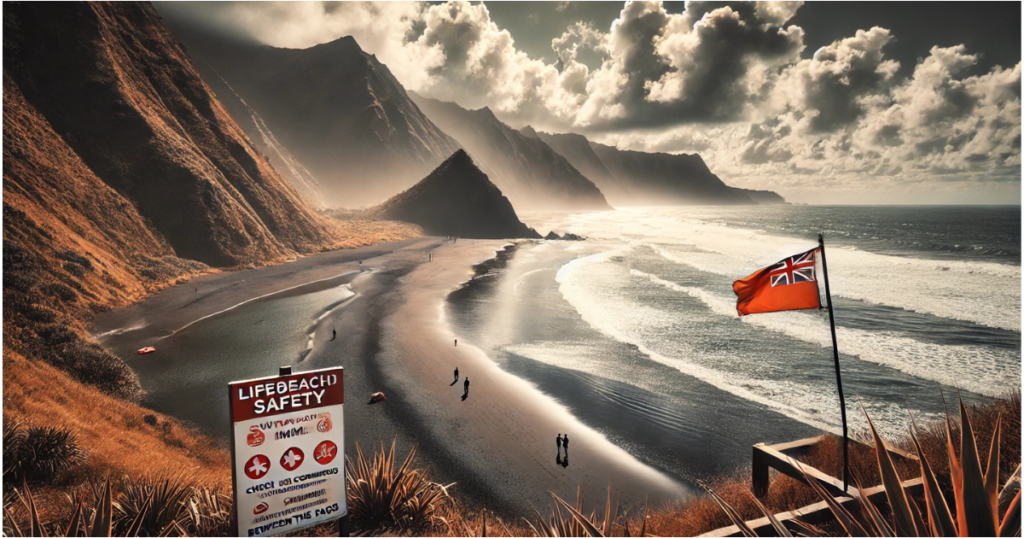Karekare Beach, nestled on New Zealand’s wild west coast, is a place of unparalleled natural beauty. With its black sand, towering cliffs, and dramatic surf, it’s no wonder this beach has captured the hearts of locals and tourists alike. However, its raw beauty comes with inherent risks, leading many to ask: “Is Karekare Beach safe?” or “Is Karekare Beach safe to swim?”

In this in-depth guide, we’ll explore the potential dangers of Karekare Beach, provide essential Karekare Beach safety tips, and help you make the most of your visit while staying safe.
The Allure of Karekare Beach
Karekare Beach is one of New Zealand’s most iconic coastal destinations. Located approximately 35 kilometers west of Auckland, it’s part of the Waitakere Ranges Regional Park. The beach gained international fame after being featured in the critically acclaimed movie The Piano. Its remote location, surrounded by lush native bush and cascading waterfalls, makes it a haven for nature lovers, photographers, and adventurers.
However, Karekare’s isolation and rugged environment also contribute to its reputation as a potentially dangerous destination. Understanding the risks and how to mitigate them is key to enjoying this stunning beach safely.
Is Karekare Beach Safe? Understanding the Risks
While Karekare Beach is undeniably beautiful, it’s important to recognize the hazards that come with its wild and untamed nature. Here are some of the primary dangers:
1. Powerful Rip Currents
Rip currents are one of the most significant dangers at Karekare Beach. These strong, narrow currents flow from the shore out to sea and can quickly pull even experienced swimmers into deeper water. According to Surf Life Saving New Zealand, rips are responsible for the majority of beach rescues and drownings in the country.

2. Unpredictable Waves
The surf at Karekare is known for its power and unpredictability. Waves can vary dramatically in size and strength, making it challenging for swimmers and surfers to navigate safely. Sudden changes in wave patterns can catch even seasoned beachgoers off guard.
3. Remote Location
Karekare Beach is less developed than many other popular beaches, which means fewer amenities and limited access to emergency services. In case of an accident, help may take longer to arrive compared to more accessible locations.
4. Changing Weather Conditions
The west coast of New Zealand is notorious for its rapidly changing weather. Sunny skies can turn stormy in a matter of minutes, increasing the risk of hypothermia, strong winds, and dangerous surf conditions.
5. Strong Winds
Karekare is often subject to strong westerly winds, which can create hazardous conditions for swimming, surfing, and even walking along the beach. These winds can also make it difficult to hear warnings or calls for help.
Is Karekare Beach Safe to Swim?
The question “Is Karekare Beach safe to swim?” is a common one, and the answer depends on several factors. While swimming at Karekare can be safe under the right conditions, it’s essential to exercise caution and follow safety guidelines.

1: Lifeguard Patrols
During the summer months, lifeguards patrol Karekare Beach and designate safe swimming areas with flags. Always swim between these flags, as they indicate the safest spots free from strong currents and rips.
2: Know Your Limits
If you’re not a confident swimmer, it’s best to avoid venturing too far into the water. Stick to shallow areas and always swim with a buddy.
3: Check Conditions
Before heading into the water, check the surf conditions and weather forecast. Avoid swimming during high surf, stormy weather, or when strong winds are present.
Karekare Beach Safety Tips: How to Stay Safe
To ensure your visit to Karekare Beach is both enjoyable and safe, follow these essential Karekare Beach safety tips:
1: Swim Between the Flags
If lifeguards are on duty, always swim within the designated safe zones marked by flags. These areas are monitored for hazards and provide the safest swimming conditions.
2: Respect the Ocean
Never turn your back on the waves, and avoid swimming alone. If you’re caught in a rip current, stay calm and swim parallel to the shore to escape.
3: Check the Weather and Tide Conditions
Before heading to the beach, check local forecasts and tide charts. Avoid swimming during high surf or stormy conditions.
4: Stay Close to Shore
If you’re not a confident swimmer, stay in shallow water and avoid venturing too far out.
5: Be Aware of Your Surroundings
Karekare Beach is remote, so ensure you have a fully charged phone and let someone know your plans before heading out.
6: Wear Appropriate Gear
If you plan to swim or surf, wear a wetsuit to protect against cold water and strong winds. Additionally, consider using a flotation device if you’re not a strong swimmer.
7: Avoid Risky Behavior
Don’t attempt to swim in areas with strong currents or large waves, and never dive into unknown water.
8: Stay Hydrated and Protected
Bring plenty of water, sunscreen, and protective clothing to guard against the sun and wind.
How Karekare Beach Compare to Other Dangerous Beaches?
Karekare Beach shares similarities with other dangerous beaches around the world, such as Bondi Beach in Australia and Piha Beach, another black-sand beach in New Zealand. Like Karekare, these beaches are known for their strong currents and unpredictable waves, making them both beautiful and hazardous.

For example, Bondi Beach is famous for its powerful rips and crowded surf, while Piha Beach, located just north of Karekare, is equally renowned for its challenging conditions. If you’re planning to visit other beaches, it’s worth learning about their specific risks. For instance, Myrtle Beach in the U.S. is known for its rip currents, while Muriwai Beach in New Zealand is famous for its powerful surf and nesting gannets.
- Is Muriwai Beach Dangerous? Understanding the Risks and Safety Tips
- How to Go to Piha Beach from Auckland: The Ultimate Travel Guide
- Walks at piha beach
- Why Is Bondi Beach So Dangerous? Safety Tips for Surviving Bondi Beach in 2025
- Why Is Myrtle Beach So Dangerous?
- Why Is Piha Beach So Dangerous?
Exploring Karekare Beach Beyond Swimming
While swimming is a popular activity at Karekare Beach, there are plenty of other ways to enjoy this stunning location safely:
1: Hiking
The Waitakere Ranges offer numerous hiking trails with breathtaking views of the coastline. The Karekare Falls track is a must-visit, leading to a picturesque waterfall just a short walk from the beach.
2: Photography
Karekare’s dramatic landscapes make it a paradise for photographers. Capture the black sand, rugged cliffs, and rolling waves for unforgettable shots.
3: Picnicking
Pack a picnic and enjoy a meal with a view. There are several sheltered spots near the beach where you can relax and take in the scenery.
4: Surfing
For experienced surfers, Karekare offers challenging waves. However, always check conditions and surf within your ability.
Conclusion
Karekare Beach is undoubtedly one of New Zealand’s most breathtaking coastal destinations, offering a unique blend of natural beauty and adventure. However, its raw and untamed environment comes with inherent risks that demand respect and preparation. By understanding the dangers, such as powerful rip currents, unpredictable waves, and rapidly changing weather, you can make informed decisions to ensure your safety.

Always prioritize swimming between the flags when lifeguards are on duty, and avoid venturing too far into the water if you’re not a confident swimmer. Checking weather and tide conditions before your visit is crucial, as is respecting the ocean’s power. Whether you’re swimming, surfing, hiking, or simply enjoying the scenery, staying aware of your surroundings is key to a safe and enjoyable experience.
Karekare Beach’s remote location adds to its charm but also means you should take extra precautions. Let someone know your plans, carry a fully charged phone, and be prepared for emergencies. By following the essential Karekare Beach safety tips outlined in this guide, you can minimize risks and fully appreciate the beach’s stunning landscapes.
Remember, the ocean is unpredictable, and even the most experienced beachgoers can encounter challenges. Respecting nature and staying informed are the best ways to ensure your visit to Karekare Beach is memorable for all the right reasons. For more insights on beach safety and other dangerous beaches around the world, visit Ocean Beach Tour. Stay safe, and enjoy the magic of Karekare Beach responsibly!
FAQs
1. Is Karekare Beach safe for swimming?
Karekare Beach can be safe for swimming, but only under the right conditions. Always swim between the flags when lifeguards are on duty, and avoid swimming during high surf or stormy weather. If you’re not a confident swimmer, stay in shallow water.
2. What are the main dangers at Karekare Beach?
The main dangers at Karekare Beach include powerful rip currents, unpredictable waves, strong winds, and rapidly changing weather conditions. Its remote location also means emergency services may take longer to respond.
3. Are there lifeguards at Karekare Beach?
Lifeguards patrol Karekare Beach during the summer months. They designate safe swimming areas with flags, so always swim between these flags for added safety.
4. Can beginners swim at Karekare Beach?
Beginners should exercise caution when swimming at Karekare Beach. It’s best to stick to shallow areas and avoid venturing too far into the water. If possible, swim with a more experienced companion.
5. What should I do if I get caught in a rip current?
If you’re caught in a rip current, stay calm and avoid fighting against it. Swim parallel to the shore until you’re out of the current, then swim back to the beach. If you’re unable to escape, wave your arms and call for help.
6. Is Karekare Beach safe for children?
Karekare Beach can be safe for children if proper precautions are taken. Always supervise children closely, keep them in shallow water, and ensure they swim between the flags when lifeguards are present.
7. What are some essential Karekare Beach safety tips?
Some essential safety tips include swimming between the flags, checking weather and tide conditions, respecting the ocean, staying close to shore, and avoiding risky behavior. Always be aware of your surroundings and let someone know your plans before heading out.
8. How does Karekare Beach compare to other dangerous beaches?
Karekare Beach shares similarities with other dangerous beaches like Bondi Beach in Australia and Piha Beach in New Zealand. These beaches are known for their strong currents and unpredictable waves, making them both beautiful and hazardous.
9. Are there other activities to enjoy at Karekare Beach besides swimming?
Yes, Karekare Beach offers plenty of activities besides swimming. You can go hiking on the Waitakere Ranges trails, take photos of the stunning landscapes, enjoy a picnic, or surf if you’re experienced.
10. Where can I find more information about beach safety?
For more information on beach safety, visit Ocean Beach Tour to explore guides on other dangerous beaches around the world.
